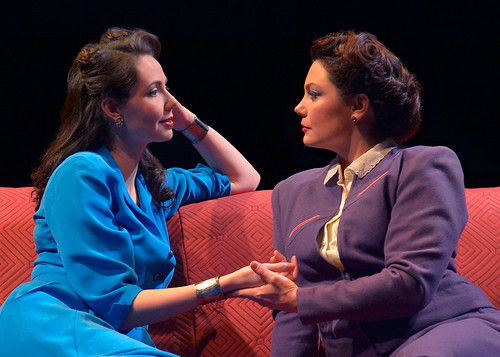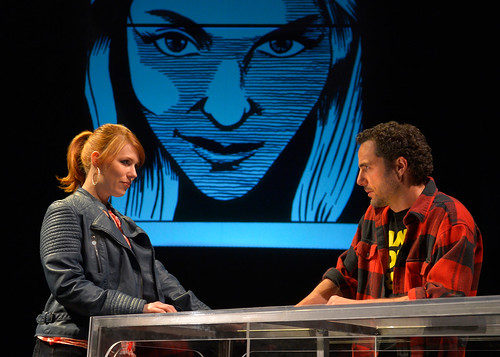Fifty shades of Wonder in Marin Theatre Co.'s Lasso
 Liz Sklar (left) as The Amazon and Jessa Brie Moreno as The Wife in the world premiere of Carson Kreitzer's Lasso of Truth at Marin Theatre Company. Below: Lauren English is The Girl and John Riedlinger is The Guy with one of over 200 illustrations by Jacob Stoltz in the background. Photos by Kevin Berne
Liz Sklar (left) as The Amazon and Jessa Brie Moreno as The Wife in the world premiere of Carson Kreitzer's Lasso of Truth at Marin Theatre Company. Below: Lauren English is The Girl and John Riedlinger is The Guy with one of over 200 illustrations by Jacob Stoltz in the background. Photos by Kevin Berne
You're bound to like Carson Kreitzer's Lasso of Truth if you like Wonder Woman...and a heaping helping of S&M on the side.
If you didn't know the two were related, first of all, think about it for a minute (the golden lasso, the bustier, the metal bracelets, etc.), and second of all, boy has Kreitzer got an origin story for you. Commissioned by Marin Theatre Company, the play is part of the National New Play Network, which means this is what they call a "rolling world premiere." The show begins in Mill Valley then heads to Atlanta and Kansas City.
So where did Wonder Woman come from (and we're not talking about Paradise Island, home of the Amazons)? For many of us, she sprung fully formed in the 1970s looking like the stunning Lynda Carter in a patriotic bathing suit and gold accessories. That famous TV show is actually a jumping-off point for Kreitzer's play.
She has a contemporary woman (Lauren English) telling the audience about a great betrayal in her life. As a lifelong fan of Wonder Woman (spurred by Carter and the TV show), she was horrified to learn that the character's creator, William Moulton Marston, was, in her words a "perv."
From the present, we jump into the past to explore Marston's so-called perversion. In the years leading up to Wonder Woman's first comic book appearance in 1941, Marston, a psychologist and academic (and inventor of an early version of the polygraph), was shucking convention. An admirer of strong, beautiful women, he was married to just such a woman, and he's often seen sitting at her feet, looking up at her adoringly while she strokes his hair as if he were a prize poodle. But then Marston's research assistant entered the picture, and then she really entered the picture. Marston, his wife and his mistress crafted a polyamorous relationship that led to a bundle of children and relationships within the triangle that could handle the deepest, darkest explorations of S&M, bondage and erotically charged, emotionally fraught exchanges of power.
It's fascinating stuff, and Kreitzer, working with director Jasson Minadakis, does something quite extraordinary here in that she handles what really amounts to an exploration of unconventional sexuality with sensitivity and, perhaps most importantly, a sense of humor. It could be pretty deadly watching grown-ups explore their sexuality with ropes on a stage, but all of that is handled well. Nicholas Rose as Marston (here called "The Inventor"), Jessa Brie Moreno as his wife and Liz Sklar as the girlfriend (who, it's worth mentioning, bears a passing resemblance to Lynda Carter) create dimensional characters prone to candor, enthusiasm and risky exploration. Sklar, it turns out, is also a whiz with knots.
The 2 1/2-hour show feels long in stretches. In Act 1, when the action shifts from the Marston triangle to English and her quest to find the original comic in which Wonder Woman first appears, these scenes feel like a distraction. She's tangling with a geeky comic book store clerk (John Riedlinger) about the comic, about feminism, about her sense of betrayal with Marston's real-life proclivities. But these scenes, despite the charms of English and Riedlinger, come off as strident and shallow.
But by Act 2, the contemporary scenes have become more interesting as our modern duo explores an actual relationship, and their characters emerge more strongly. In this act, the distractions come from a too-often repeated gimmick of darkening the theater and having the actors making sexy talk into microphones as they negotiate (sometimes with humor) the games they'd like to play. There's also a goofy lie-detector machine on stage in Act 2 that looks like a reject from Forbidden Planet and is just a little too silly.
Other technical aspects of the show are marvelous. Annie Smart's set provides efficient sliding panels to effectively frame the video designs by Kwame Braun and the terrific graphic art by Jacob Stoltz that never lets us forget that we're firmly in the world of comic books. There are also some very funny videos involving Gloria Steinem (as played by Moreno), who was a Wonder Woman champion and put her on the cover of Ms. magazine's inaugural issue in 1972.
The past and the present do come together eventually, but Kreitzer doesn't seem to know how or where to end the play, which stutters its way to a conclusion. The impression she gives us of Marston (an endearing idealist who believed a comic book character could end war and bring about utopia) and the powerful women in his life is quite a strong one. That they all contributed in some way toward the creation of a positive role model for girls and women is clear, but the punch of their story ends with a pow rather than POW!
[bonus interview]I talked with Lasso of Truth playwright Carson Kreitzer for the San Francisco Chronicle. Read the story here.
FOR MORE INFORMATIONCarson Kreitzer's Lasso of Truth continues through March 16 at Marin Theatre Company, 397 Miller Ave., Mill Valley. Tickets are $37-$58. Call 415-388-5208 or visit www.marintheatre.org.
